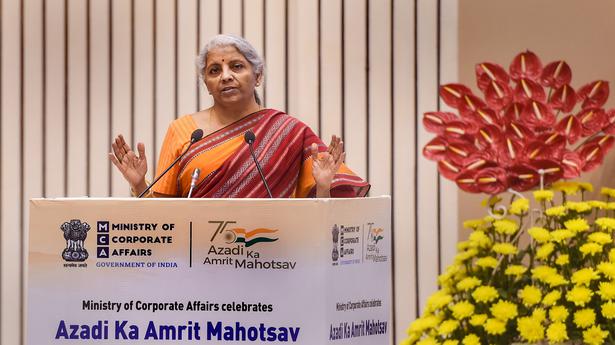
Retail investors acting like shock absorbers in stock market: Nirmala Sitharaman
The Hindu
The Union Finance Minister was speaking at an event of the Corporate Affairs Ministry as part of the Azadi ka Amrit Mahotsav.
Amid continuing volatility in the stock market, Union Minister for Finance and Corporate Affairs, Nirmala Sitharaman on Tuesday, June 7, 2022, said retail investors seem to act as shock absorbers even when foreign portfolio investors went away.
Ms. Sitharaman, who was speaking at the event to flag off Iconic Day celebrations of the Corporate Affairs Ministry as part of the Azadi ka Amrit Mahotsav (AKAM) said, that during the pandemic, there has been a very significant increase in retail investor numbers.
“Retail investors have come in a big way that they seem to act like shock absorbers... if FPIs went away, our markets did not really have to show their ups and downs in a very distinct way because small investors in the country have come in a big way,” she said.
In March, the Central Depository Services (India) Ltd said the number of active Demat accounts opened with it touched the six crore mark.
In recent months, the stock market has been witnessing significant volatility and foreign portfolio investors going on a selling spree amid tightening monetary policy actions to curb rising inflation and geopolitical tensions.
The Finance Minister further said regulators and other entities should be well advanced and ahead of the curve in understanding digitisation to ensure that there is no misuse of technologies.
Ms. Sitharaman also emphasised the need to have firewall mechanisms in the context of digitisation.

The Union Budget unveiled on February 1, 2025, has come at a time of unprecedented global uncertainty and a flagging domestic economy. The real GDP growth is estimated at 6.4% for 2024-25 and between 6.3-6.8% for 2025-26, a far cry from >8 percent growth required annually to make India a developed nation by 2047. While much attention has been devoted to the demand stimulus through income tax cuts, not enough is said about the proposed reforms in urban development, tariff rationalisation, and regulatory simplification aimed at making Indian cities and corporates more competitive. Since the majority of economic activity is located in cities (urban areas account for ~55% of GDP) and produced by large corporates (~40% of the national output and 55% of India’s exports), the above-mentioned reforms have a pivotal role in improving India’s trend growth rate. Below we unpack each reform.












